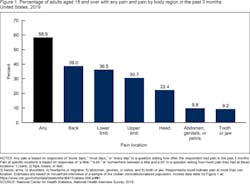Back, lower limb, and upper limb pain among U.S. adults, 2019
The National Institutes of Health (NIH) surveyed adults about how often the respondent had pain in the past 3 months and the location. In 2019, 39.0% of adults had back pain, 36.5% had lower limb pain, and 30.7% had upper limb pain in the past 3 months. Adults aged 65 and over, women, non-Hispanic white adults, and those with income below 100% of the federal poverty level (FPL) were most likely to experience back pain.
Adults aged 18–29 (21.0%), men (33.5%), non-Hispanic Asian adults (20.6%), and those with income 200% of FPL or above (35.2%) were least likely to experience lower limb pain. Adults aged 65 and over, women, non-Hispanic white adults, and those with income below 100% of FPL were most likely to experience upper limb pain.
Location-specific pain, such as back, neck, arm, and hip pain is associated with short- and long-term health effects, ranging from minor discomfort to musculoskeletal impairment diminished quality of life and escalating healthcare costs. Existing studies of location-specific pain are mostly limited to small or special populations with limited generalizability.
This report provides national estimates of any pain regardless of body region as well as estimates of back, lower limb (hips, knees, or feet), and upper limb (hands, arms, or shoulders) pain in the past 3 months among U.S. adults aged 18 and over by selected sociodemographic characteristics:
- The percentage of adults aged 18 and over experiencing pain in the past 3 months varied by body region.
- Overall, 58.9% of adults experienced pain of any kind in the past 3 months.
- Back pain (39.0%) was the most prevalent site for pain, followed by lower limb (36.5%); upper limb (30.7%); headache or migraine (22.4%); abdominal, pelvic, or genital (9.8%); and tooth or jaw (9.2%).
The percentage of adults aged 18 and over with back pain differed by demographic characteristics:
- The percentage of adults with back pain increased with age, from 28.4% for those aged 18–29 and 35.2% for those aged 30–44 to 44.3% for those aged 45–64 and 45.6% for those aged 65 and over (Figure 2).
- Women (40.6%) were more likely to experience back pain than men (37.2%).
- Estimates of back pain differed among non-Hispanic white (42.7%), non-Hispanic black (35.8%), Hispanic (31.2%), and non-Hispanic Asian (24.5%) adults.
- The percentage of adults with back pain decreased as family income increased, from 44.8% in adults with income less than 100% of the federal poverty level (FPL) to 37.6% in adults with income 200% or more of FPL.
